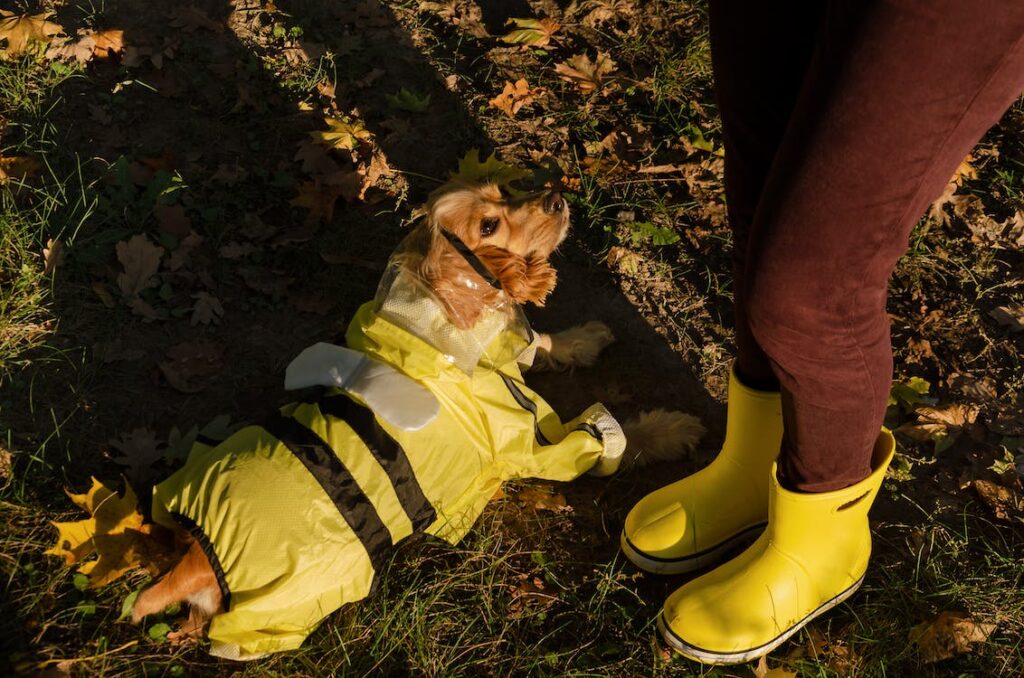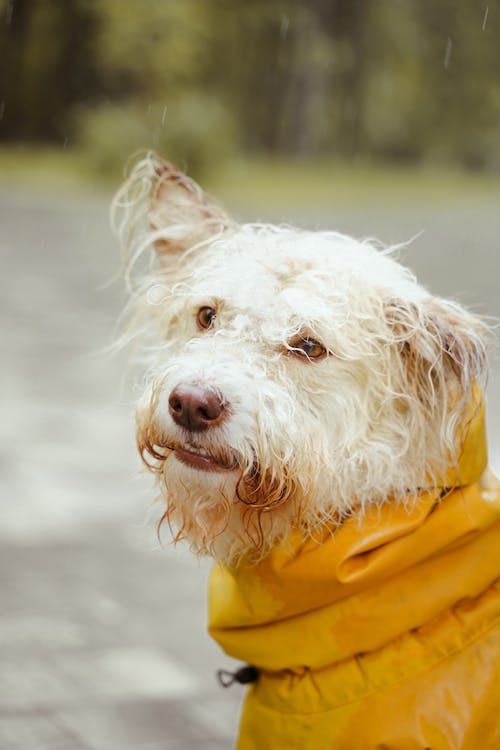Should Dogs Wear Raincoats?

Should Dogs Wear Raincoats?
Yes. When it comes to dressing up our furry friends, dog owners are often divided on the question of whether dogs should wear raincoats. Some argue that dogs have natural fur coats and are built to withstand various weather conditions, while others believe that raincoats can provide protection and comfort for dogs during wet and rainy days. In this article, we will explore the benefits of raincoats for dogs, considerations for choosing the right raincoat, and address some common concerns dog owners may have.

Benefits of Raincoats for Dogs
Protection from Rain
Just like humans, dogs can get wet and uncomfortable in the rain. Raincoats provide a barrier between the dog’s fur and the rain, helping to keep them dry. This is particularly important for short-haired breeds or dogs with health conditions that make them more susceptible to cold and dampness.
Keeping Dogs Dry and Comfortable
Wet fur can lead to discomfort, skin irritation, and even potential health issues for dogs. Raincoats can help prevent their fur from becoming soaked, reducing the risk of skin problems and keeping them comfortable during outdoor activities.
Maintaining Good Health
Raincoats not only protect dogs from rain but also help to prevent them from ingesting harmful chemicals or pollutants that may be present in puddles or rainwater. Additionally, raincoats can minimize the amount of dirt, mud, and debris that dogs bring into the house, making it easier to keep their living environment clean and hygienic.
Choosing the Right Raincoat for Your Dog
Proper Fit
When selecting a raincoat for your dog, it’s essential to choose the right size and ensure a proper fit. The raincoat should cover your dog’s back and chest adequately without restricting their movement or causing discomfort. Measure your dog’s chest and back length to find the appropriate size, and consider adjustable straps for a more customized fit.
Material and Durability
Opt for raincoats made from waterproof or water-resistant materials, such as nylon or polyester. These materials provide effective protection against rain while being lightweight and durable. Look for reinforced seams and secure fastenings to ensure the raincoat stays in place even during active play or walks.
Easy to Clean and Maintain
Dogs love exploring, which means their raincoats are likely to get dirty. Opt for a raincoat that is simple to clean and maintain. Seek out options that are machine-washable or can be easily wiped clean. Quick-drying materials are also beneficial, allowing you to reuse the raincoat promptly.

Common Concerns about Dog Raincoats
Restricting Natural Movement
One concern some dog owners have is that raincoats may restrict their dog’s natural movement. However, well-designed raincoats provide a balance between protection and freedom of movement. Look for raincoats with adjustable straps and flexible fabrics that allow your dog to move comfortably without feeling restricted.
Overheating and Breathability
Another concern is the potential for overheating if dogs wear raincoats for extended periods. To address this, choose raincoats with breathable materials that allow proper airflow. Look for features such as mesh linings or vents that facilitate ventilation and prevent overheating, especially in warmer climates.
Introducing a Raincoat to Your Dog
Introducing a raincoat to your dog may require some patience and training. Start by associating the raincoat with positive experiences, offering treats and praise while gradually acclimatizing your dog to wearing it. Take it step by step and allow your dog to adjust at their own pace.
How to Introduce Your Dog to a Raincoat
Positive Reinforcement
Use positive reinforcement techniques to create a positive association with the raincoat. Reward your dog with treats, praise, and affection when they show interest in or wear the raincoat. This will help them associate the raincoat with pleasant experiences.
Gradual Acclimatization
Introduce the raincoat gradually. Begin by letting your dog sniff and explore the raincoat while rewarding them for calm behavior. Slowly progress to putting the raincoat on for short periods, gradually increasing the duration until your dog becomes comfortable wearing it.
Patience and Persistence
Every dog is different, so be patient and persistent during the training process. Some dogs may take longer to adjust to wearing a raincoat, while others may accept it more readily. Stay consistent with training and provide reassurance and support to help your dog become accustomed to the raincoat.
While dogs have natural fur coats, raincoats can provide additional protection, comfort, and health benefits during wet and rainy weather. They help keep dogs dry, maintain their overall well-being, and minimize the mess brought indoors. When choosing a raincoat, consider the proper fit, materials, and ease of maintenance. Introduce the raincoat gradually using positive reinforcement techniques, allowing your dog to adjust at their own pace.
FAQs (Frequently Asked Questions)
Can all dogs wear raincoats?
Most dogs can wear raincoats, but it’s important to choose the right size and ensure a proper fit for comfort and functionality.
How often should I wash my dog’s raincoat?
The frequency of washing depends on usage and how dirty the raincoat gets. Generally, aim to wash it when it becomes visibly dirty or after extended use.
Are raincoats suitable for puppies?
Yes, raincoats can be suitable for puppies. Choose a raincoat specifically designed for puppies or opt for adjustable raincoats that can grow with them.
Can raincoats help dogs with anxiety during storms?
While raincoats may provide some comfort, dogs with storm anxiety may require additional strategies such as creating a safe space or using calming techniques.
Can I leave my dog’s raincoat on indoors?
It’s generally recommended to remove the raincoat once indoors to prevent overheating and allow your dog’s fur to breathe.
Does Your Dog Need a Raincoat
Whether or not your dog needs a raincoat depends on a few factors, including their breed, the climate you live in, and their activity level. Some dogs, such as those with short hair or thin coats, may benefit from wearing a raincoat in cold or wet weather. Others, such as those with thick coats or who live in warm climates, may not need a raincoat at all.
Do dogs really need raincoats?
Dogs don’t necessarily need raincoats, but they can be helpful for some dogs. If your dog has a short coat or is prone to getting cold, a raincoat can help keep them dry and warm. Raincoats can also help protect your dog’s skin from the elements and prevent mud and dirt from getting on them. Ultimately, whether or not your dog needs a raincoat is a personal decision.
Do rain jackets help dogs?
Rain jackets for dogs provide protection from rain, keeping them dry and comfortable. They prevent skin issues, reduce dirt brought indoors, and are lightweight and breathable. Essential for rainy days!
Why do people put raincoats on dogs?
There are a few reasons why people put raincoats on dogs.
To keep them dry: Raincoats can help keep dogs dry in wet weather, especially dogs with short hair or thin coats. This is important for dogs’ health, as being wet can lead to hypothermia and other problems.
To protect their skin: Raincoats can also help protect dogs’ skin from the elements, such as rain, snow, and wind. This is especially important for dogs with sensitive skin.
To keep them warm: Raincoats can also help keep dogs warm in cold weather. This is especially important for dogs who are not used to the cold.
To make them more visible: Raincoats can make dogs more visible to cars and other people in low-visibility conditions, such as fog or rain. This can help prevent accidents.
To keep them clean: Raincoats can help keep dogs clean by preventing mud and dirt from getting on their fur. This can make it easier to clean your dog after a walk in the rain.
does my German shepherd need a raincoat?
A raincoat can benefit your German Shepherd by keeping them dry and comfortable in wet weather. It helps protect their fur, prevent skin issues, and maintain overall health. Consider investing in one for your furry friend!




